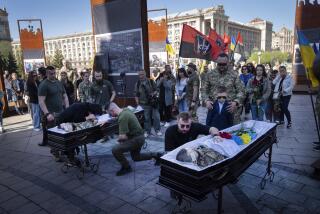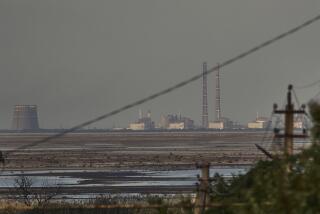Soviets Report Nuclear Accident : Radiation Cloud Sweeps Northern Europe; Termed Not Threatening
- Share via
MOSCOW — The Soviet Union said Monday that an accident has occurred at one of its nuclear power plants, sending a cloud of atomic radiation sweeping across Scandinavia and Finland hundreds of miles away.
In a terse announcement, the Soviet news agency Tass said the accident damaged an atomic reactor at the Chernobyl power station north of Kiev in the Ukraine.
“Measures are being undertaken to eliminate the consequences of the accident,” Tass said, indicating that such efforts were still under way when the report was made public.
“Aid is being given to those affected,” Tass added. “A government commission has been set up”--presumably to investigate the cause of the accident.
No other details were disclosed in what was the Soviet Union’s first public acknowledgment of a nuclear accident. It was therefore not known if “those affected” referred to people who may have been injured or evacuated in the accident.
Loss of Life Feared
The official disclosure and the relative swiftness with which it was made prompted Western diplomats to speculate that it was a major accident. One said the statement “almost certainly indicated that the death toll was high.”
Another Western diplomat said: “The wording of the announcement indicated this was a very serious accident. It is not unreasonable to speculate about deaths.”
Still another diplomat, noting that the accident occurred not far from Kiev, which has a population of 2.4 million, said, “It (the accident) obviously must be harmful. It sounds harmful to the people of Kiev, but there is no way to measure the levels of radiation (there).”
First indications of a nuclear accident came on Sunday from Finland and Sweden, where authorities disclosed that they had detected increased radiation levels north of Stockholm, more than 750 miles northwest of the Chernobyl plant site. They said the radiation was carried to Scandinavia by prevailing winds. Finland, Denmark and Norway all reported increased levels.
Return to Normal Expected
All the countries said that radiation levels were not dangerous and that air quality was expected to return to normal in a few days.
But Lars Erik de Geer of Sweden’s Defense Research Agency said, “It must have been a relatively big accident, since we have received such high levels of radiation from so far away.”
He said the radiation levels corresponded to those recorded after nuclear weapons tests in the atmosphere during the 1970s. “I know of no earlier nuclear power plant accident which has led to such high radiation levels in this area,” he said.
In a dispatch sent after the first announcement, Tass said that the Chernobyl accident was the first in Soviet history. However, Western analysts and exiled Soviet scientists have said that a nuclear accident occurred in 1958 in the Chelyabinsk area of the Ural Mountains, killing hundreds of people and contaminating a wide area that it still off-limits to the public.
Tass’ initial disclosure of the accident came a few hours after the Swedish Embassy in Moscow reported that Soviet atomic power officials had denied knowledge of any nuclear accident on Soviet soil that could have caused the elevated radiation levels detected in Sweden.
The Soviet Union, which rarely reports on disasters within its borders, has consistently maintained that nuclear plants are not any more hazardous than conventional power generation facilities.
Clearly, Moscow was under pressure Monday to disclose news of the Chernobyl accident in view of the remarkably high radiation readings in Finland, Sweden, Denmark and Norway.
Earlier Monday, for example, Ingemar Vintersved of Sweden’s Defense Research Agency pinpointed the Soviet Union as the source of a major leak of radioactivity.
Rates in Denmark, Finland
Readings in Finland were reported to be up to six times normal levels. In Denmark, readings were two to five times higher than normal.
Swedish Energy Minister Birgitta Dahl declared that it was “unacceptable” that there had been no notification of any accident by mid-day Monday.
“We must demand higher safety standards in the Soviet Union,” she said, and Sweden may insist that the Soviet civil nuclear program be overseen by the International Atomic Energy Agency, a U.N. agency.
The Chernobyl plant, sited at a new town named Pripyat about 60 miles north of Kiev, consists of four 1,000 megawatt reactors of identical design. They were built from 1977 to 1983 and are described as light-water cooled, graphite-moderated reactors used only in the Soviet Union.
Tass, while devoting only three paragraphs to its report on the Soviet accident, at the same time ran an eight-paragraph story on nuclear mishaps in the United States, including the leak of radioactivity at the Three Mile Island plant, near Harrisburg, Pa., in 1979.
Alarm at Swedish Station
Sweden’s first inkling of a Soviet nuclear accident came when a worker at the Forsmark power station, 90 miles north of Stockholm, touched off an alarm, indicating an unexpectedly high level of radiation.
“The radiation level was very weak, but it showed on Forsmark’s sensitive equipment,” Bo Holmquist, a senior official of the regional government in Uppsala, north of Stockholm, said. He added that the levels presented no danger in Sweden.
In accordance with an alert procedure that goes into effect if a leak is suspected at Forsmark, some of the station’s employees were sent home, Holmquist said.
He said authorities began to suspect another source of radiation when similar radioactive recordings were made at a monitoring station in Nykoping, south of Stockholm.
The Swedish news agency TT, Tidningarnas Telegrambyra, said the increased radiation levels at Forsmark were discovered when employees arrived this morning.
When they enter and leave the Forsmark plant, the workers’ radiation levels are routinely checked, officials said.
What was detected was radiation of “a few millirem an hour, a dosage which is harmless to people but illegally high for discharges,” Olle Blomqvist, an information officer at the State Power Board was quoted as telling TT.
While 600 workers were sent home under the usual safety precautions, the radiation level was too low to be harmful to the public, Swedish officials said.
Other checks showed high radiation levels at many points in Sweden and neighboring Finland.
“A conclusion was reached that the (radioactive) leak was coming on the prevailing wind from the east,” a Swedish Embassy spokesman said in Moscow.
The Soviet state committee for the use of atomic energy and the state supervisory organization for atomic energy were contacted by the embassy and asked about the leak, the spokesman said.
The Soviet authorities said they knew nothing about any nuclear accident but added that they would have known if there had been such a mishap, the spokesman added. Then came the Tass announcement that a nuclear accident had indeed taken place in the Soviet Union.
More to Read
Sign up for Essential California
The most important California stories and recommendations in your inbox every morning.
You may occasionally receive promotional content from the Los Angeles Times.













